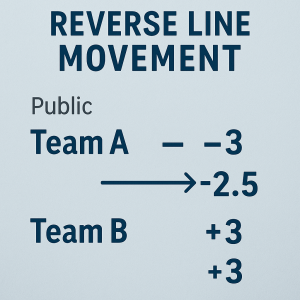 Sports betting lines move for a reason. Most of the time, it’s because oddsmakers are reacting to where the public money is going. If most people are betting on one side, the line shifts to balance action and limit risk for the sportsbook. But sometimes the line moves in the opposite direction from public betting. That’s called Reverse Line Movement (RLM), and it can be a clue that professional bettors—known as “sharps”—are influencing the market, something that also draws attention on overseas casino sites where betting trends can differ from local markets.
Sports betting lines move for a reason. Most of the time, it’s because oddsmakers are reacting to where the public money is going. If most people are betting on one side, the line shifts to balance action and limit risk for the sportsbook. But sometimes the line moves in the opposite direction from public betting. That’s called Reverse Line Movement (RLM), and it can be a clue that professional bettors—known as “sharps”—are influencing the market, something that also draws attention on overseas casino sites where betting trends can differ from local markets.
What Reverse Line Movement Means
Reverse Line Movement happens when the betting line moves against the majority of wagers. For example:
- The public is heavy on Team A at -3.
- Instead of moving the line to -3.5 or -4, the sportsbook adjusts it to -2.5.
On the surface, this doesn’t make sense. If most of the bets are on Team A, why make the line more attractive for them? The answer is that sharps are usually hitting the other side, Team B. Books respect sharp money more than public money, so they shade the line accordingly.
In short:
- Public money is about volume.
- Sharp money is about influence.
RLM is the market showing you where sharp bettors are likely getting involved.
Why Sportsbooks Move Lines This Way
Sportsbooks aren’t in the business of gambling. They want balanced action, predictable risk, and a guaranteed edge from the juice. When casual bettors pile on one side but sharp bettors are hammering the other, books adjust the line to respect the sharper positions.
Here’s why:
- Sharps bet bigger amounts. A single sharp wager can equal hundreds of smaller public bets.
- Sharps win long-term. Sportsbooks know sharp money is informed. Ignoring it would leave them exposed.
- Public bettors lose over time. Their action matters for liquidity but rarely for shaping closing lines.
Reverse Line Movement is essentially the book saying: “Yes, the majority likes Team A, but the respected money is on Team B, and we’re siding with it.”
A Classic Example
Let’s say 70% of tickets are on the Lakers -6 against the Suns. Casual fans see the Lakers as the stronger team and load up. Then, instead of moving to -6.5 or -7, the line drops to -5.5.
What’s happening? Sharps are likely on the Suns. They may have seen a matchup edge, an injury angle, or believed the Lakers’ line was inflated. The public bet volume is high on Los Angeles, but the sharp money on Phoenix is strong enough to push the line the other way.
If you followed the market here, you’d identify the Suns as the sharp side, thanks to RLM.
How to Spot Reverse Line Movement
You don’t need inside contacts to see RLM. You can track it with a few key tools:
- Betting percentages – Look at where the majority of tickets are and compare that to where the money is.
- Line history – Check how the spread, moneyline, or total has moved since opening.
- Consensus reports – Many sportsbooks and data services provide public betting splits.
When the public is stacked one way, but the line moves the other, you’ve spotted RLM.
Why Bettors Use RLM as a Strategy
The idea behind betting with Reverse Line Movement is simple: follow the smart money. If sharps are winning in the long term, siding with them should give you a better chance of success.
Advantages include:
- Clues to hidden value. RLM can highlight plays where the public is overreacting, and sharps are exploiting the line.
- Market confirmation. If you already like a side, RLM can strengthen your confidence.
- Contrarian edge. You’re betting against the public, which historically loses over time.
But it’s not foolproof.
Limitations and Risks
Reverse Line Movement should be a tool, not the entire strategy. Here’s why:
- Not all RLM is sharp-driven. Sometimes books adjust lines for injury updates, weather, or lineup changes. That can look like RLM even when it’s not.
- Public money matters more in prime games. NFL Sundays or March Madness bring in massive public action, so RLM signals are stronger there. A random Tuesday baseball game? Less so.
- Line movement noise. Not every half-point adjustment means sharps are involved. Small moves can be a book’s testing of balance.
Unthinkingly betting every RLM you see isn’t sustainable. The sharp side doesn’t always win, and books know that.
How to Use RLM Wisely
Here are some practical tips for applying Reverse Line Movement in your betting approach:
- Combine it with research. Don’t just chase the move—understand the matchup, injuries, and situational angles.
- Look for strong signals. Big games with heavy public action make RLM more meaningful.
- Follow the closing line. Late sharp moves closer to game time carry more weight than early shifts.
- Be selective. RLM works best as part of a disciplined strategy, not as your only filter.
The Takeaway
Reverse Line Movement is a window into how sharp bettors influence the market. It reveals when sportsbooks prioritize sharp money over the public. For disciplined bettors, RLM can be a helpful clue, especially when paired with research and selective play.
But it’s not a magic formula. Sometimes the sharp side loses. Sometimes what looks like RLM is just a reaction to new information. The edge comes from knowing when to trust the signal and when to stay away.
If you treat RLM as one piece of the puzzle instead of the entire picture, it can help you make sharper, more informed bets—and keep you aligned with the players who move the market.


